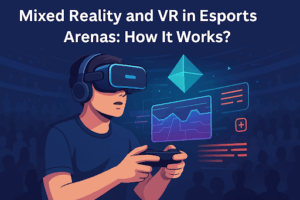Esports arenas in 2025 no longer rely on giant screens alone. Fans and players now share a mixed reality where digital layers blend with physical events. Platforms such as https://1xbet.tz/mobile demonstrate how advanced technologies connect competitions with global communities, offering seamless engagement both on-site and online.
VR headsets, augmented layers, and interactive projections turn arenas into living stages. Audiences see holograms on the floor, real-time stats floating above players, and interactive leaderboards. This immersive approach redefines how matches are watched, making every event a spectacle beyond the game itself.
The basics of mixed reality in arenas
Mixed reality combines real-world setups with digital overlays. Cameras capture every angle of the game. Software then projects enhanced visuals into the physical arena. Fans without headsets can still see effects through large displays. The result is a shared hybrid experience.
| Feature | How it Works | Impact on Fans |
| AR overlays | Adds data to real space | Boosts understanding |
| VR headsets | Creates full immersion | Unique player’s view |
| Motion tracking | Follows player moves | Dynamic highlights |
Virtual reality for players and spectators
VR setups allow players to train and compete in digital arenas with near-zero lag. Spectators use VR to join virtual stands. They can walk around, interact with others, or watch replays from multiple angles. This makes esports a closer mirror to physical stadium events.
Integration with live broadcasting
Mixed reality links broadcasts and arenas. During matches, broadcasters show overlays with heat maps, reaction times, and player perspectives. This extra content keeps both remote and in-person viewers hooked.
Sponsors now appear within VR layers. Their logos are placed on virtual billboards, interactive booths, and even player avatars. This provides new monetization models without cluttering physical arenas.
Why fans embrace the shift
Fans enjoy mixed reality because it blends convenience and spectacle. They get closer to the action and learn more about tactics. Engagement rises when spectators feel part of the environment, not just passive viewers.
Hardware and software ecosystem
The backbone of mixed reality involves cameras, sensors, servers, and projection systems. VR headsets evolve to reduce motion sickness and deliver higher refresh rates. Software platforms keep data synchronized for thousands of users at once.
| Component | Example Use | Benefit |
| Sensors | Track players | Accurate overlays |
| Servers | Handle data flow | Smooth experience |
| Headsets | Provide VR | Deeper immersion |
Use of mixed reality outside arenas
Training centers also adopt VR and mixed reality. Teams practice under simulated pressure conditions. Coaches analyze plays with 3D replays projected into rooms. This adds strategic depth.
Remote fans benefit too. Some events sell VR tickets, letting users attend virtually. Others provide AR-enabled apps for live stats at home. This keeps digital communities tied closely to arena experiences.
Growing role of platforms
Services with simplified onboarding, such as 1xbet promo code tanzania, highlight the need for easy access. Fans and sponsors demand smooth entry points to interactive ecosystems. Platforms adapt by streamlining access to VR-enabled matches and tournaments.
Three reasons mixed reality matters in esports
The popularity of mixed reality is fueled by three main factors:
- Fans want deeper engagement during events.
- Sponsors need interactive and measurable exposure.
- Teams gain strategic advantages through VR training.
These reasons explain why arenas invest in technology at scale.
Global adoption
Regions adopt mixed reality at different speeds. Tech-heavy areas already invest in VR headsets for fans. Other regions focus on AR apps due to cost efficiency. Both approaches fuel growth and expand the reach of esports events.
| Region | Popular Tool | Reason |
| Asia | VR headsets | High-tech adoption |
| Europe | AR apps | Lower cost entry |
| North America | Mixed setups | Diverse audience |
Revenue impact
Mixed reality increases ticket sales, merchandise revenue, and sponsor value. Reports suggest interactive features can raise fan spending by up to 25%. Broadcasters also gain higher ratings with enhanced coverage. Mixed reality tools attract universities and cultural institutions. They support events, research VR, and connect students with industry opportunities. Esports thus expands beyond entertainment into education and culture.
Mixed reality and VR transform esports into immersive, interactive worlds. Arenas become stages where physical and digital layers meet. For fans, this means more than just watching – it means stepping inside the action. For sponsors and teams, it ensures growth, innovation, and stronger ties with global audiences.
